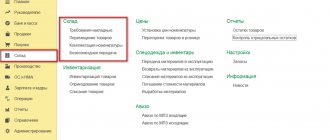How can selling goods under a commission agreement be beneficial? To whom and in what cases does it make sense to choose it? How to formalize a commission correctly and to the mutual satisfaction of the parties? How is a commission trading scheme if a commission agreement is concluded between organizations that apply different taxation regimes? We will answer these and other questions in our article.
It is convenient to trade consignment goods in the MyWarehouse service. In it, you can accept goods for sale with a commission agreement, keep records of them, automatically generate a report to the consignor after the sale, look at profitability, and issue a return if the product is not sold. Register and try it now: it's free!
Try MySklad
- Advantages of trading under a commission agreement
- How commission trading is processed
- Commission trading: special cases The commission agent sold the goods more expensive or cheaper than expected
- The contract was not fulfilled
- Subcommission
- The commission agent did not sell a single product during the reporting period
Advantages of trading under a commission agreement
If you are engaged in retail trade and have found a supplier who agrees to give you goods for sale under a commission agreement, you are in luck. And you’re especially lucky if you’re just starting out in business. The law allows money to be given for goods purchased under a commission agreement after it has been sold. That is, a commission trading scheme allows you to start working without large investments and without special risks.
If you produce a product or purchase it in large quantities for subsequent retail sale at different points, then a commission trading scheme can also be beneficial for you. At a minimum, this will increase the sales market. Some small store, located in a place where you yourself would not work, can quickly sell out goods that are not sold in your traditional outlets. At the same time, the store may not be able to buy a batch of such goods, but it will gladly accept it on commission.
The commission trading scheme is also beneficial because it makes it easier to process the return of goods than under a sales contract. If the product was purchased under the “purchase and sale” scheme, then in order to return it from the store back to the supplier, it is necessary to carry out a reverse sale. This creates problems in terms of taxation - when one of the parties to the transaction does not pay VAT, the second loses money because it cannot deduct VAT. If the delivery of goods is formalized under a commission agreement, this problem does not arise. The intermediary simply writes off the goods from off-balance sheet accounting and returns them to the supplier. However, when returning goods taken on consignment, there are some subtleties, and we will return to them in this material.
Commission trading concept
Commission trading is a form of trading that involves the sale of used products. This can be either used clothing or antiques. Collectors, people who want to make a purchase at the lowest possible cost, resort to the services of commission points. As a rule, the owner of a used property enters into an agreement with the seller for the sale of the property. The seller sells the product and receives a reward for it. Let's look at the basic concepts:
- The principal is the owner of the property that is rented to the thrift store.
- A commission agent is a person who sells goods.
- A buyer is a person who buys goods in thrift stores not for the purpose of entrepreneurial activity.
Question: Does the principal need to pay VAT under the simplified tax system if the commission agent, when selling his goods, issued an invoice to the buyer with the allocated amount of VAT? View answer
An agreement is concluded between these persons, the terms of which are determined individually. Let's look at the most common conditions:
- If the goods were successfully sold, the money is received by the consignor on the third day.
- To receive funds, you need to have a passport and a receipt issued by a thrift store.
- If the goods cannot be sold, they are returned to the consignor. The latter must compensate the seller for storage costs. They cannot exceed 3% of the cost of the product.
If the principal does not show up to collect the money, the funds received are transferred to the local budget.
Question: Is the sale by commission agents and agents of express payment cards for services (communications, IP-telephony, Internet, etc.) and SIM cards for mobile phones recognized by retail trade? View answer
Labeling of remnants of consignment goods received from individual entrepreneurs or legal entities
According to labeling rules, consignment stores receive already labeled shoes and clothing from individual entrepreneurs and organizations. That is, the responsibility for applying identification means in this case is assigned to the principal (owner of the product). Individual entrepreneurs and legal entities can act as participants in the turnover, register in the “Honest ZNAK” system and place an order for receiving stamps.
Transfer of marked goods is carried out using electronic UPD documents, which display product data, including Data Matrix codes.
To mark the remains of commission shoes and clothing that are actually in the possession of the commission agent, the following is done:
- The principal describes the balances according to a simplified scheme. Orders identification tools, and upon receipt prints them on a printer. Applies barcode labels to each item of goods and puts them into circulation.
- When transferring marked products, a “Shipment” document is generated, where the “Commission” type is indicated. There the identification codes are presented in a list, the recipient, TIN, and other information are indicated. With a large number of products, doing this manually is quite problematic. In this case, you can use special services to automate downloading via API or using file exchange with your personal account “Honest Sign”.
- The commission agent, in turn, goes to his personal account and in the documents section accepts the sent file (in the list of incoming documents). To do this, you must first click on the desired line, and then certify the document and confirm acceptance. From this moment on, the marking codes become the property of the commission agent.
Working with electronic documents requires a qualified digital signature, which is necessary for their certification.
Further sale of marked balances is carried out using an online cash register. OFD automatically transmits data on the withdrawal of goods from circulation to the Chestny ZNAK system.
Description of residues
For leftovers, a description of goods according to a simplified scheme is acceptable. This means that only 4 attributes can be specified. All actions are carried out through the personal account of the information system for monitoring and traceability of labeled products:
- 1. The file “Description of balances” is generated in the “Documents” section. It has general details: the entrepreneur’s TIN and the first two digits of the product nomenclature code. All that remains is to specify additional parameters.
- 2. The ordering of marking codes is carried out through the OMS (order management station). When creating a new order, the required fields in the header are filled in. Then you go to the section with goods (by clicking on the corresponding button).
- 3. Lines are added, codes from the catalog are written. You will also need to indicate the number of stamps required for the order.
After describing the goods, you can create an order to receive marking codes, print them, apply them to the goods and put them into circulation.
Regulatory acts
Paragraph 1 of Article 990 of the Civil Code of the Russian Federation specifies the concept of commission trading. This is the implementation of a sale on behalf of the principal by a commission agent in the presence of an appropriate order. According to paragraph 1 of Article 990 of the Civil Code of the Russian Federation, it is the commission agent who bears obligations to the buyer. Received items, in accordance with paragraph 1 of Article 996 of the Civil Code of the Russian Federation, remain the property of the principal until the moment of sale.
How does the principal issue invoices when selling goods through a commission agent ?
The seller, according to Article 999 of the Civil Code of the Russian Federation, after the sale sends a report to the former owner, and also transfers to him the funds under the previously executed agreement. The committent also has some obligations. Based on paragraph 1 of Article 991 of the Civil Code of the Russian Federation, he must pay the seller a remuneration, the amount of which must correspond to the terms of the agreement. Article 1001 of the Civil Code of the Russian Federation states that the seller may demand reimbursement of his expenses incurred during the sale of products.
Sale of insurance policies
Situation: is it possible to apply UTII when selling insurance policies on the basis of agency agreements with insurance companies?
Answer: no, you can't.
An insurance policy is a standard form of a written agreement between the policyholder and the insurer (Article 930 of the Civil Code of the Russian Federation). Therefore, the policy is not a commodity. And entrepreneurial activity for the sale of insurance policies (insurance services) cannot be classified as retail trade. Accordingly, it is not subject to UTII. A similar point of view was expressed in the letter of the Ministry of Finance of Russia dated July 19, 2007 No. 03-11-05/162.
Types of stores
Commission points are classified depending on the specifics of their activities:
- Sale of used property (for example, second-hand goods).
- Sales of new goods at a discount.
- Mixed sales (confiscated items, production surplus, new items at a discount).
Commission points are divided into types depending on what kind of product they sell. Shops can sell furniture, clothing, vehicles, antiques, and weapons. They are divided into types depending on the type of calculations:
- Cash.
- Non-cash.
- Availability of installments.
The most common form of thrift stores is second-hand stores. Used cars are also often sold.
How to choose an assortment
The main task of such stores is to create an assortment that will be in demand. There are many people who want to hand over their belongings, but how to figure it out and navigate through it all is a difficult question. In order not to get confused in all the variety of goods, modern second-hand shops choose a narrow specialization. The success of such a store is determined by whether the entrepreneur correctly determined:
- potential buyers;
- volume and quality of items accepted into the store;
- store promotion methods.
Commission trading rules
The terms of trade are established by Government Decree No. 569 dated 06.06.1998. The act states that a legal entity with any organizational structure or individual entrepreneur can become a commission agent. The store has the right to accept property from foreigners and stateless persons. The agreement between the parties must include this information:
- Details of both parties.
- Description of the transferred property: degree of wear, presence of defects, name, quantity.
- Product cost.
- Reward amount.
- Opportunities for property valuation.
- The time period allotted for the sale of goods.
- Payment terms.
Other conditions may be specified in the agreement, but they should not violate the rights of the property owner. Some products have special requirements. For example, a car can be accepted by a store only if there are documents for it. Jewelry is accepted by the commission agent on the basis of Resolution No. 55.
The following items cannot be accepted into the store:
- Products withdrawn from circulation.
- A product whose sales are limited.
- Products for the treatment of diseases.
- Personal hygiene products.
When products are accepted into the store, labels are attached to them indicating the cost.
The owner of the property must provide all information about the object: expiration date, compliance with legal requirements. Acceptance is carried out on the basis of the owner's passport. The seller may provide additional services: delivery of products to the store, assessment of objects. The owner can refuse to sell the property at any time. However, he is obliged to pay remuneration to the seller. The amount of remuneration, as well as the value of the property, are determined by agreement of the participants.
Property transferred to the store goes on sale no later than the next business day. If there is a delay due to the fault of the seller, the latter must pay a penalty to the owner. If the seller sells the property on more favorable terms than prescribed, the benefit is divided equally between the participants.
Trading places
If a stationary facility in which retail trade is carried out does not have trading floors, then for the purposes of UTII it is recognized as a trading place. In this case, a trading place means a place used for carrying out retail purchase and sale transactions (Article 346.27 of the Tax Code of the Russian Federation).
Physical indicators for calculating UTII for this form of trade can be:
- number of retail spaces (if the area of each retail space does not exceed 5 sq. m);
- area of the retail space (for retail spaces whose area exceeds 5 sq. m).
The concept of “trading area” is not defined in tax legislation. According to the Russian Ministry of Finance, the area of a retail space should be considered the entire area of a stationary retail facility, including utility, administrative, storage and other premises in which customer service is not provided (letter of the Russian Ministry of Finance dated August 10, 2009 No. 03-11-09 /274). The same position is reflected in the Resolution of the Presidium of the Supreme Arbitration Court of the Russian Federation dated June 14, 2011 No. 417/11.
The area of a retail space is determined by title and inventory documents (paragraph 22 of article 346.27 of the Tax Code of the Russian Federation). For example, on the basis of purchase and sale agreements for non-residential premises, technical passports, floor plans, diagrams, explications, lease (sublease) agreements for non-residential premises or their individual parts (paragraph 24 of Article 346.27 of the Tax Code of the Russian Federation).
Situation: is a stationary retail facility considered to have a trading floor if the facility consists of several premises, but only one is used for trading? The documents separately indicate the area of the retail space (more than 5 sq. m), warehouse and utility rooms.
Considering that there are no official explanations from regulatory agencies on this matter, in the situation under consideration, you can use the conclusions contained in the Resolution of the Presidium of the Supreme Arbitration Court of the Russian Federation dated June 14, 2011 No. 417/11.
When conducting retail trade through stationary facilities with trading floors and without trading floors, UTII is calculated taking into account various physical indicators. In the first case, the tax base is determined based on the area of the sales floor, which does not include the area of auxiliary premises. In the second - based on the area of retail spaces, which includes the area of auxiliary premises.
Based on the provisions of Article 346.27 of the Tax Code of the Russian Federation, the Presidium of the Supreme Arbitration Court of the Russian Federation explained that a stationary retail facility can be qualified as an object with a sales floor if the following conditions are met:
- the object consists of several separate rooms;
- the title documents indicate the intended purpose of each separate premises;
- title documents make it possible to accurately determine the area of premises that are used to display goods, serve customers and carry out payments (i.e., premises that are actually trading floors).
If these conditions are met, UTII must be calculated based on the area of the sales floor. Regardless of whether the term “trading floor” is mentioned in the title documents or not. With this option, the areas of warehouses, administrative and service premises and utility rooms are not included in the calculation of UTII.
If at least one of the above conditions is not met, UTII must be calculated based on the area of the retail space, taking into account the area of all auxiliary premises.
Accounting for product sales
Even when the property arrives at a thrift store, the consignor remains its owner. Therefore, the goods are recorded on off-balance sheet account 004 “Products accepted for commission” at the cost indicated in the acceptance documentation. That is, the accounting includes the cost established by both parties to the agreement. When selling property, the cost must be written off from off-balance sheet account 004.
At the time of shipment, the buyer's receivable debt appears, as well as the seller's payable debt to the owner. Accounts payable are formed in the amount of the value at which the property was sold. In accounting, the seller must make an entry for DT account 62 and CT account 76.
Funds sent from the buyer to the commission agent will not be considered either income or expenses.
The remuneration paid to the seller is considered income from the basic form of activity. It must be recorded according to CT account 90 (subaccount 90-1) and DT account 76. Profit is recognized at the time the owner approves the seller’s report. The expenses incurred by the seller when selling products will not be considered expenses of the commission agent for tax purposes on the basis of paragraph 9 of Article 270 of the Tax Code of the Russian Federation.
Marking of remaining goods received from individuals
According to generally accepted rules, the commission agent ensures the labeling of unmarked goods accepted for sale under a commission agreement from individuals who are not individual entrepreneurs.
Scheme for marking remaining goods under a commission agreement:
- 1. The commission agent creates a description according to a simplified scheme (based on 4 attributes). The system assigns a unique code to the product - GTIN.
- 2. Orders marking codes in the required quantity (each unit of goods has its own identifier). Receives them, unloads them from the control system, and prints them.
- 3. Puts marking codes into circulation.
The cost of marking codes is 50 kopecks (this amount does not include VAT). You must pay for your order after receiving the invoice. Marking codes are stored in the system for a limited time (defined individually for each group of goods). Once they are produced, they can be printed and applied to products. For printing, use a label printer or office printing device.
Accounting entries
Let's look at the entries used by a thrift store accountant:
- DT004. Receipt of property from the owner.
- DT62 KT76. Selling products in a consignment store.
- KT004. Write-off of the cost of products from the off-balance sheet account.
- DT76 KT76. The seller's expenses associated with the sale of products.
- DT76 KT51. Payment for storage of products.
- DT76 KT90-1. Revenue from intermediary services.
- DT90-3 KT68. Calculation of VAT on revenue from intermediary services.
- DT51 KT62. Transfer of funds from the buyer.
- DT76 KT51. Transfer of funds to the former owner of the property.
- DT51 KI76. Receiving reimbursement of expenses from the owner.
Postings are confirmed by primary documents.
Consignment store costs
The initial investment will be minimal. At the start you will have to spend money on:
- Equipment – 60 thousand rubles
- Rental of retail space – 15 thousand rubles
- Advertising - both free promotion tools can be used here (for example, advertisements in a newspaper or the Internet), as well as paid ones - advertising in elevators will be the most effective. Minimum budget – 5 thousand rubles;
- Drawing up the necessary forms, contracts and other documents (the minimum price is 1000 rubles for each) – 5 thousand rubles;
- The cost of registering a business is 5 thousand rubles.
- Unforeseen expenses - 10 thousand rubles
Total initial costs will be 100 thousand rubles.
In addition to the initial investment, you need to plan your monthly expenses:
- Rent of premises – 15 thousand rubles;
- Salary to the seller – 17 thousand rubles;
- Consumables (paper for printing contracts, receipt paper, office supplies, etc.) – 3 thousand rubles;
- Taxes – 5 thousand rubles.
Total monthly expenses will be 40 thousand rubles.
Features of taxation
An invoice is issued to the buyer within 5 days after the sale of the goods. Intermediary services provided by a consignment store are subject to VAT. The tax base is the amount of remuneration paid to the seller. VAT accrued on remuneration is recorded on DT account 90.
Proceeds from the sale of property will not be taken into account for tax purposes as part of the seller's income. The corresponding instructions are given in paragraph 1 of Article 251 of the Tax Code of the Russian Federation. The seller's expenses that will be reimbursed are not considered expenses on the basis of paragraph 9 of Article 270 of the Tax Code of the Russian Federation.
You might also be interested in:
Online cash registers Atol Sigma - how to earn more
How to make a return to a buyer at an online checkout: step-by-step instructions
MTS cash desk: review of online cash register models
Scanners for product labeling
Shoe marking for retail 2021
Online cash register for dummies
Did you like the article? Share it on social networks.
Add a comment Cancel reply
Also read:
GIS Mercury Rosselkhoznadzor background information
Mercury Rosselkhoznadzor is a system for electronic certification and control over the circulation of goods subject to state veterinary supervision.
This is a single information platform for production owners, veterinary services, and sellers whose work is related to agricultural products. "Mercury" belongs to VetIS - the state system in the field of veterinary medicine. The operator of the Federal State Information System (FSIS) Mercury is Rosselkhoznadzor. From July 1, 2018, any movement of goods… 571 Find out more
Patent for individual entrepreneurs in 2021 - changes in PSN
A patent for an individual entrepreneur will look different in 2021.
Federal Law No. 373-FZ introduced a number of amendments to the patent taxation system, making its conditions more favorable for entrepreneurs. In our article we will analyze in detail the changes to PSN in 2021 for individual entrepreneurs: permitted and prohibited types of activities, conditions for retail trade and public catering, tax holidays and preferential transition for former... 697 Find out more
What taxes does an individual entrepreneur pay on the simplified tax system?
Taxes for individual entrepreneurs under the simplified tax system are somewhat different from contributions from entrepreneurs under other taxation systems.
The taxpayer receives a low interest rate, simple reporting, and the opportunity to reduce taxes through insurance payments. “Simplified” is aimed at representatives of small and medium-sized businesses. This regime is especially popular among individual entrepreneurs without employees - with a small income, the tax can be reduced to almost zero. The simplified tax system is regulated by Chapter 26.2 of the Tax Code of the Russian Federation. Quarterly… 928 Find out more







